There’s no denying that the COVID-19 coronavirus has made life challenging for businesses – especially ones where contractors come into close contact with the public. Nowadays, consumers are more wary about being in close proximity to people outside their families. As a plumber, you still need to operate your business and earn a living. With Read more
Customer Service

There’s no denying that the COVID-19 coronavirus has made life challenging for businesses – especially ones where contractors come into close contact with the public. Nowadays, consumers are more wary about being in close proximity to people outside their families.
As a plumber, you still need to operate your business and earn a living. With that in mind, how can you streamline your plumbing business during COVID-19? Here are a few ways to help create a safer working environment, protecting both yourself and your customers:
Accept Only Contactless Payments
Cash might have been an acceptable choice before the COVID-19 pandemic. However, it’s crucial you adapt how payments get accepted by your business. You can achieve that goal by politely refusing cash payments and only taking contactless ones.
These days, it’s easier than ever to accept debit and credit card payments from customers while you’re out on site. Try this point of sale system, for example, to accept card payments using a mobile card reader terminal.
Such solutions can even print receipts out for customers, which they can tear off the mini receipt-printer themselves. Alternatively, you could offer to email your customers an invoice for their payment.
Today’s mobile payment solutions also work with NFC devices like smartphones. They give your customers even more contactless payment options for convenience and safety.
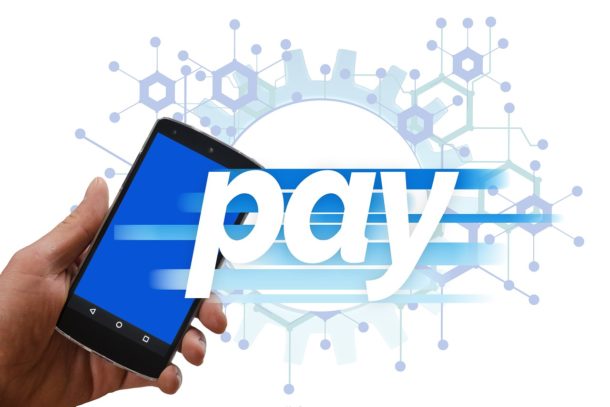
Offer Customers Remote Video Quotes
As a plumber, your work will often require you to visit customer’s homes and business premises to survey any problems or work needed before offering a quote. As you can imagine, it makes sense to socially distance yourself from others as much as possible.
An innovative way to furnish customers with quotes for any non-emergency work is by having a video call with them. You can then ask them to point their mobile device to the areas where work is required so you can do a visual inspection remotely.
Both iPhones and Android devices come with free video call software (FaceTime and Google Duo, respectively). Alternatively, you could both use other methods, such as WhatsApp, Facebook Messenger, or Zoom.
Ask Customers to Email Images of Plumbing Issues
Another way to provide quotes to your customers remotely is by asking them to take photographs that illustrate any plumbing problems they are experiencing and email them to you.
You can then use that visual evidence to determine the most likely cause of their problems and provide an accurate quote for any remedial work. If it’s more convenient for them, your customers could send the messages to you via Facebook Messenger or WhatsApp.
If the problem relates to a leaking pipe or faucet, for example, you could also ask them to take a short video clip of the issue on their mobile device and share that with you instead.
Provide Receipts Electronically
Lastly, if you usually fill out a receipt from a duplicate or triplicate receipt book, it makes more sense to send receipts electronically to your customers. Again, this can get done via email or through one of the various social networking messaging apps.

The plumbing industry has been essential through the rise of the pandemic over the last year or so. Thankfully, this means many plumbers have been able to continue working (while adhering to COVID-19 guidelines) rather than losing out on all essential work. However, because of the rate the virus spreads, there’s also a very large Read more
The plumbing industry has been essential through the rise of the pandemic over the last year or so. Thankfully, this means many plumbers have been able to continue working (while adhering to COVID-19 guidelines) rather than losing out on all essential work. However, because of the rate the virus spreads, there’s also a very large chance that many people have put off plumbing issues in their homes in fear of letting someone new into their homes.
Now there’s a light at the end of the tunnel and vaccines are beginning to be administered into the most vulnerable people, the rate of infection and other statistics should continue to drop. This means the world can get back to some sort of normality, and this means more people will be willing to let plumbers into their homes to fix their problems. However, with so many plumbers like you out there, how are you going to ensure you get your fair share of customers? Take a look at these effective methods to increase your customer base in a post pandemic era.
Show case studies
Case studies are a wonderful way of proving to potential clients that you can do the best work, whether it’s tightening a leaking pipe or fitting a new bathroom. At each project, take plenty of pictures (with the owner’s consent, of course) and use them on your website and at each pitch to help get potential customers on board with you, rather than other plumbers.
Continue to abide by safety laws
Even when everyone has had their vaccines, there’s still bound to be fear for many potential customers that the virus could be spread in their home. Continuing to abide by safety laws in your country or region will help them feel at ease. Many business owners are taking advice from Carlos Ramirez Safety to ensure the work they’re doing is as safe as possible for both themselves, and their clients. A professional plumber is almost always more likely to be hired over someone who’s not willing to put safety first.
Talk about your services on social media
Social media is the way forward in this day and age, and if you want to attract more customers, you should be using platforms like Facebook and Instagram to showcase the work you’re doing. Much like case studies, you can use pictures and videos to show transformations you’ve completed, as well as displaying your contact details and price list. Using the right hashtags will help you reach the right people and doing it consistently will ensure they call you when they have a plumbing issue.
Create an offer that’s hard to refuse
Finally, all plumbers will be looking to increase their customer base once restrictions begin to lift, so you need to get ahead of the game. Create offers and discounts for new and returning customers to help ensure people choose you over your competitors. Remember to always reward loyalty, and welcome new customers differently to make each customer feel as special as possible.

Throughout the years, the forces that have driven the plumbing industry to change and improve have been diverse. From competitors trying new things, to technological advances pushing boundaries, contractors have had to adapt, or get left behind. One driving force that hasn’t always been recognized, however, is the customer. Sure, good contractors and managers have Read more
Throughout the years, the forces that have driven the plumbing industry to change and improve have been diverse. From competitors trying new things, to technological advances pushing boundaries, contractors have had to adapt, or get left behind. One driving force that hasn’t always been recognized, however, is the customer.
Sure, good contractors and managers have always taken into account that customer satisfaction is what keeps a business running, from invaluable word of mouth recommendations to the ever-profitable returning customer strategies, but the fact of the matter is that customers themselves have changed. Tech giants like Amazon and Facebook permeate every aspect of our culture and they’ve reshaped expectations so much that simply doing a good job just isn’t enough anymore.
The fact that customers expect so much from every company they interact with (even if they’re not a tech giant) has already been discussed and dissected. After all, 2020 was the year customer experience became more important than price. Now, the pressure is on plumbing and contracting companies to make sense of these expectations and find a way to implement changes. That, however, is easier said than done. How do you turn a plumbing company into Amazon?
This is where customer journeys come in. And no, that’s not a typo. We do mean customer journeys, as a plural. That’s because the complete sum of interactions between a customer and a field service business is not singular; their experience is made up of many interactions that require individual attention, but ignoring this fact is an error that many managers make.
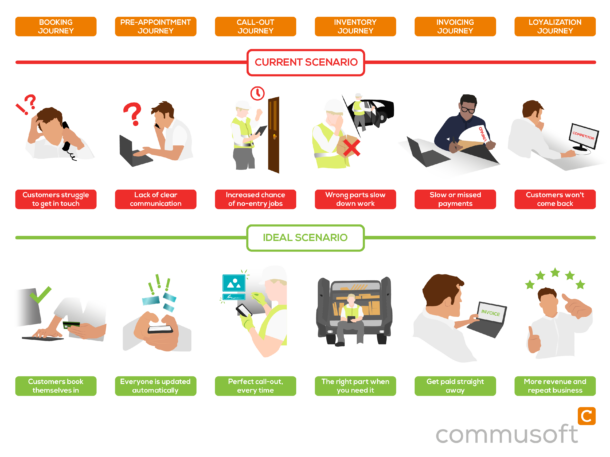
1. The customer isn’t the most important one, they’re the only one!
For example, what’s the first thing a customer has to do in order to hire you? Book an appointment, right? Well, that’s the booking journey. How many steps are there to go from needing a plumber to having an appointment scheduled? Where do you lose customers along the way? How can you remove friction so that the process is so smooth, the customer never gets a chance to change their mind?
Basically, if you can turn your booking journey into something resembling Amazon’s “1-Click Buy” button, you’ll have significantly improved your lead conversion rate. You’ll earn more money for each dollar spent on getting leads to your website, increase your chances that the customer will continue through to the next journey, and encourage re-bookings in the future.
The same applies throughout each additional journey, as highlighted in the image above. The more points of friction you have, the more negative the overall experience and that’s even if the customer’s problem was fixed! It can be overwhelming (especially to smaller businesses) to take into account every single interaction, but by mapping the customer journey, it becomes far more manageable.
For example, in the booking journey we mentioned above, most people expect to book an appointment the same way they book a dinner reservation. Therefore, an automatic booking portal is the tool you need to offer that experience. A quote? Why would they wait days for the office staff to send one, or even weeks, when they’re so used to seeing prices online?
Providing instant digital quotes will impress the customer, help upsell them on premium plans (because they can clearly see their options and the benefits shown on multiple quotes), and save your admin time.
Learn more about online portals and customer experience here!
2. How do plumbing technicians benefit from great customer journeys?
The reason customer journeys will define 2021 as well as the coming years (a bold claim, we know!) is because despite the name, rather than targeting a single shareholder, it stands as a holistic strategy for a business.
From a technician’s point of view, an easy job is one they can do as efficiently as possible. That means taking as few trips back and forth to the office between jobs (ideally none), for the customer to be aware of the visit & available when they do arrive, and finally: to be able to support any query the customer may have, all whilst in the field.
When you’re aiming to offer a smooth pre-appointment, call-out, and inventory journey to your customers, all these imply having the right tool to make your technician’s day fly by. The customer is kept up-to-date via notifications so they know to be are available, and technicians can expect to know whether the parts the installation needs are available; these are just a few of the benefits that work to make everyone’s lives easier.
3. How does your office staff benefit from great customer journeys?
Frictionless customer journeys are tightly linked to the concept of customer self-service and business automation. Much like booking a stay on Booking.com, the customer does part of the work, whilst software takes care of reminders, invoicing, and even feedback requests.
On the customer side, they’re happy because they feel in control of their experience and can get results quickly with near instantaneous confirmations every step of the way, establishing peace of mind.
The admin side is where the greatest benefits truly lie.
Software automation can’t replace office staff when it comes to complex tasks and building relationships, but it can support them to deliver their best work by removing repetitive and time-consuming parts of their day, like emailing confirmations and double-data entry. More efficient admins means you can hire more technicians, and get more work done with the same amount of resources.
4. The Takeaway
All in all, customer journeys are a complex concept and no one expects a business owner to get it perfect from the beginning. However, as we move into 2021 and learn to live with the challenges we’ve faced in 2020, it’s true that customer expectations will continue to rise, but quality customer journeys can help you face them.
Digital tools are already a mainstay of our everyday lives and Commusoft is one that strives to make remarkable customer journeys a breeze for any contracting business. If you’re looking to learn more, check out our Customer Journeys page.
 Cristina Maria is a Marketing Executive at Commusoft, a job management software company, where she helps educate and empower field service businesses to deliver a remarkable customer experience.
Cristina Maria is a Marketing Executive at Commusoft, a job management software company, where she helps educate and empower field service businesses to deliver a remarkable customer experience.
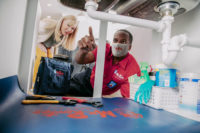
There’s a long-held assumption that the more technology you introduce to your business model, the less human interaction you get. Unfortunately, this rationale causes many businesses to put so much emphasis on their digital capabilities that customer service standards go to the wayside. When you’re in the business of plumbing, delivering your essential services will Read more
There’s a long-held assumption that the more technology you introduce to your business model, the less human interaction you get. Unfortunately, this rationale causes many businesses to put so much emphasis on their digital capabilities that customer service standards go to the wayside.
When you’re in the business of plumbing, delivering your essential services will always require interaction with your customers at some stage of the process. Therefore, providing poor customer service and hoping your advanced technology makes up for it might as well be a death sentence for your business.
In reality, technology should not be seen as a replacement for excellent customer service, but rather as a necessary tool for enhancing the overall customer experience.

For Mr. Rooter Plumbing, a Neighborly company, we’ve found in recent years that not only does implementing various advanced plumbing technologies such as the use of video inspection equipment or video conferencing and consultations improve the work we do in the homes of our customers but incorporating technology into the customer relations aspect of our business has led to happier, more loyal customers across our global network. Here’s why…
Customers want convenience, and so do providers
Today’s consumers make their purchase decisions based primarily on convenience and instant gratification. Which restaurant is available and can deliver quickest through my favorite food delivery app? Which clothing store has a user-friendly website and offers free two-day shipping? The same mindset comes into play when looking for a home service provider: Which plumber is easiest to contact and can get the job done most efficiently?
Always try to think from the customer’s perspective. If someone is in need of a plumber, chances are they are stressed enough as it is. The least you can do for them is simplify the request and scheduling process with online and mobile options. Ideally, this simplifies things for you as the contractor as well. There is no need to invest all of your time, talent and resources in creating an intricate website for online scheduling, when the best approach is to make it simple and attractive with consumer-friendly usability. The more user-friendly your system is, the more customers you’ll attract. And with more customers, there’s a greater need for an intuitive system to help you keep track of those leads.
Technology can play a particularly important part in helping to improve the efficiency of phone systems. If you are a larger plumbing company that receives frequent phone calls, you may want to consider using technology to organize calls so that fewer calls are missed. This could include using call center workforce management software to allocate calls along with virtual phone menus.
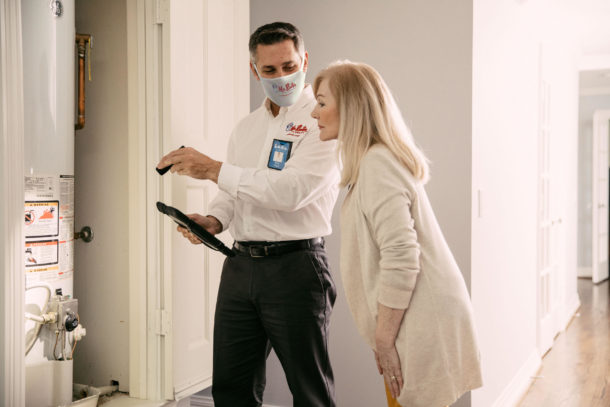
Customers expect professionalism
If a homeowner is paying a professional to complete a home service project for them, they want to feel confident that their money is going toward someone who knows what they’re doing. In the past, a plumber’s success was based on how well they could “paint a verbal picture” of the issue and its solution for a customer. Nowadays, a plumber who arrives with a mobile device or tablet ready to visually explain their recommended approach instantly increases his/her credibility as a trusted advisor as opposed to a salesman. Figuring out how to appropriately use technology to convey expertise is a skill that requires more advanced and ongoing training of your technicians, but it’s worthwhile to ensure your team can respond to service requests with the utmost professionalism.
Electronic communication also streamlines transactions between providers and customers. Invoices can be delivered directly via email so they don’t get lost in the mail. Messages can be sent and received in real time so there’s no frustration over playing phone tag. Customers can better prepare a technician for their visit by sending photos and videos of the issue at hand, which makes for a more prepared technician upon arrival. All of this conveys the image you want of an experienced and professional provider.
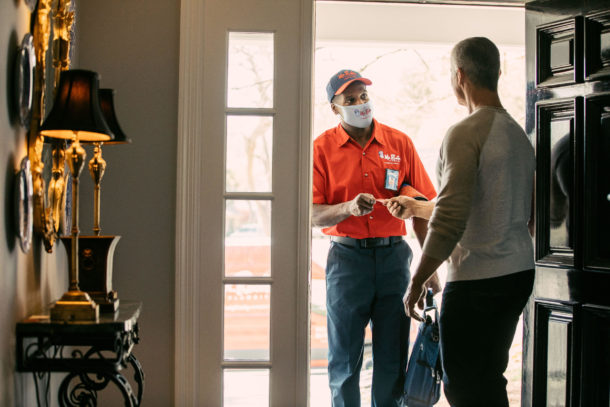
Customers want to feel safe
Being an essential service provider during a pandemic is both an opportunity and a challenge. While issues that require a plumber cannot be ignored, it is also a health risk both to the homeowner and to the technician alike for us to deliver those services directly to an individual’s home. Being invited into people’s homes in order to do our jobs is a privilege, especially in today’s environment, making it absolutely necessary to work safety measures such as wearing masks, washing hands, maintaining social distance, and more into our standard service call procedures.
With technology, we can take our precautionary measures a step further to create an experience as close to contactless as possible. Electronic capabilities for transactions such as providing estimates, sending invoices, and receiving payments are a must. For the service call itself, being digitally connected with our customers allows us to send arrival alerts, to pre-screen customers, and to possibly even provide expertise and direction entirely virtually for select home maintenance jobs that homeowners could accomplish themselves. By introducing these creative approaches to doing what is usually a very hands-on job, we show our customers that we realize giving them the best and most comfortable experience goes far beyond the job itself.
The time to evolve is now
Of course, the idea of implementing all of this advanced technology to your plumbing business may be a daunting concept for some contractors. You might even question if it’s worthwhile if the old-school business model you’ve always had is still working as far as you can tell. But with the growing prevalence of technology across all industries, chances are refusing to adapt will leave you behind your competitors who are rising to the occasion.
If you’re not comfortable making the changes yourself, consider hiring a consultant or perhaps even converting your business to a franchise model like Mr. Rooter to get the digital support you need. But one way or another, it’s time for your plumbing business to step into the future.
 Glenn Gallas is the Vice President of Operations for Mr. Rooter Plumbing, a Neighborly company. Glenn’s career in franchising began as a franchise owner in 2000 of a Mr. Rooter Plumbing franchise. Glenn became a multi-franchise owner when he purchased a Mr. Electric franchise and then a Holiday Lighting franchise. Glenn is a veteran and has served in the US Army in both the active and reserve capacity and sees franchising as the best fit opportunity for veterans transitioning from the military to civilian life.
Glenn Gallas is the Vice President of Operations for Mr. Rooter Plumbing, a Neighborly company. Glenn’s career in franchising began as a franchise owner in 2000 of a Mr. Rooter Plumbing franchise. Glenn became a multi-franchise owner when he purchased a Mr. Electric franchise and then a Holiday Lighting franchise. Glenn is a veteran and has served in the US Army in both the active and reserve capacity and sees franchising as the best fit opportunity for veterans transitioning from the military to civilian life.

As the HVAC industry evolves further in response to new market opportunities, sustainability initiatives and changing consumer demands it’s easy to be left at a loss of how to cut through the marketing speak and deliver benefit-driven information to your customers. Putting in the extra work to fully understand how to translate product features into Read more
As the HVAC industry evolves further in response to new market opportunities, sustainability initiatives and changing consumer demands it’s easy to be left at a loss of how to cut through the marketing speak and deliver benefit-driven information to your customers. Putting in the extra work to fully understand how to translate product features into real-world customer benefits will give you an edge in the market. Below is a discussion on how to navigate an industry of new and old considerations across customer demographics. Follow along to understand how you can shift your strategies to build customer relationships through simple communication training of your sales staff.
Define your competitive edge through no-nonsense delivery
Is it just me, or does every HVAC product on the market have the same features?
Tell me if you’ve heard this one before: “Our new, highly-efficient product provides homeowners with a simple, flexible, and cost-competitive solution.”
Does this sound like a product line you offer? Truth be told, this description could apply to any number of products. For example, a system that offers “zoning” could be anything from a sophisticated ductless system to a simple air conditioner with manual air dampers.
Here’s the problem: today’s customers are the most educated customer base we’ve ever experienced. With access to information at our literal fingertips in our smartphones, customers can fact-check a sales pitch in an instant. HVAC repair and replacement is an expensive investment for most customers to begin with, so it’s understood that they want to know exactly what they’re paying for.
If you state that a product is efficient, customers want to know: How efficient and what are the benefits? Compared to what? Does it cost more, if so, what’s the price difference? Do I really need it?
If you’re not being clear with your customers, you can trust that they are getting their information elsewhere — perhaps even pulling purchase decision information from your competition.
There are simple improvements to your sales information delivery that can help to move past the jargon and build meaningful conversations with your customers that leave them feeling well-informed and satisfied in their decision. In short, you can build credibility – and become the authority – by being honest and transparent.
As mentioned, using vague terms to describe a product as efficient, variable, or flexible tells the customer very little. The way to fix this is to always speak in terms of comparison. By speaking in comparisons, you will educate the customer on all of the options available to them – not just the one you’d like to sell. This is a critical step in achieving value in customer satisfaction.
If you’re not comfortable speaking in comparison, here are three ways to help get you started:
- Stop talking features & benefits and start talking sell points and personas
If you’re speaking to a customer about a solution they are just one step away in the sales funnel from making a purchase. It’s important at this stage that you carefully consider what you say and how you say it.
Consider this: most brochures you’ll hand a customer have a long list of features & benefits… those features are often phrased in comparison to an older version of that same product or directly to a competitor’s product – “Even quieter!” or “More flexible than ever!”
But the homeowner doesn’t care if it’s “even quieter” than a previous generation of a product that isn’t in the consideration set they are making for their home. Focus on the information your homeowner actually wants and needs: what options do you recommend; what specifically makes you recommend these based on my needs; how much does it cost?
Hone in on information by defining the sell points for all the products in your portfolio. An easy way to do this is to determine the five whys for each of your products:
- Who would most want or need to purchase this product?
- What type of situation is this product most suitable for?
- Why would they need this product?
- When can we promise to deliver this product to the customer?
- Where are most of the customers geographically located who need this product?
Notice the emphasis on the extremes in these questions. The goal is not to answer in general – “who could use or purchase this product” – but rather “who MOST wants or needs this product and why.” This is critical to defining the true selling points of a product.
By taking this approach, your team will be able clearly to describe the important reasons behind a recommendation because they have clear guidance as to why to recommend it in the first place. You might even consider building a questionnaire that will help both you and your customer come to a decision on the right choice for them.
- Group your product offerings using tiers
Instead of confusing customers with an onslaught of product brochures covered in brand names, shiny logos, and pretty pictures, consider packaging your products into tiers. Most homeowners are able to easily pick up the concept of Good, Better, and Best – or Bronze, Silver, and Gold.
By grouping your offering into rungs on a ladder, you’re giving the customer a baseline to compare products against one another. The key to this approach is to ensure your groupings offer key differences. Perhaps package A is best for the cost-conservative homeowner, package B is best for the energy-conscious customer, while package C is most suitable to the customer seeking a quick turnaround.
With this system, customers can easily determine the difference between your products and make informed decisions on which products best fit their needs.
-
Give three options whenever possible
When ordering drinks at your local coffee shop, why is it so many of us opt for the medium size? A small seems too small, and a large seems, well…too large. When we are given three options, often we are seeking the Goldilocks “just right” feeling.
No one wants to miss out on an upsell, but the goal should not be to dupe your customer into buying the highest-margin product by failing to tell them about a more cost-effective option that likely checks off the needs on their list. Provide customers with three options: something that doesn’t quite meet their needs, something that over-delivers, and a solution that falls in the middle. Because you have tuned in to exactly what the customer needs, selling the middle option in comparison to the other two should be simple.
If you are the service provider for all three options, this strategy gives you an added bonus. If the customer chooses the more elaborate option, you’ve earned more. If they choose the less desirable option, they will know up front what they’re getting and perhaps sacrificing – and you’ve earned their trust in the process.
What does this sound like?
The common – although tired – sales pitch I shared at the beginning turns into a richer conversation once you’ve added comparisons. In this example, I’ve uncovered that the customer is most concerned with the ability to stay comfortable in their home, with affordability being their second concern.
“The package I’d like to offer you today is our Premier package. Your upstairs and downstairs will have individual thermostats, which I know is what you were looking for. I’d like to share with you some other options for your consideration. Our Platinum package would give you even more comfort options: every room could have its own set point. The higher price could be offset with some rebates, but it is more expensive than the Premier package. Another option is our Economy package. This is the most affordable of the three, but it doesn’t come with the zoning you asked for. Given what we have discussed so far, I think the Premier package most meets your needs.”
By defining the sell points for your products, grouping them into tiers, and offering at least three options you can successfully provide the customer with a well-thought-out and easily understandable reasoning for your recommendation.
Resolve to make comparison-speak a habit in your organization and your customers will see you as a more trustworthy source of information for their buying decision process.

Pam Duffy, P.E. is the Owner of Spark One Solutions, LLC based in Dallas, TX – a marketing and business solutions consulting company based serving HVAC businesses.
She serves as a member of the AHR Expo Expert Council – a collaboration of HVACR experts and thought leaders launched by the AHR Expo in 2019 to educate and stimulate discussion concerning the biggest issues impacting the industry.
She has a mechanical engineering degree from the University of Central Florida and is a licensed PE. She has 10 years of experience in the HVAC industry and is most well-known for bringing new HVAC products to life.
Pam will be speaking more in-depth on this topic at AHR Expo 2020, and it will be a free session with attendee registration. Register HERE.
